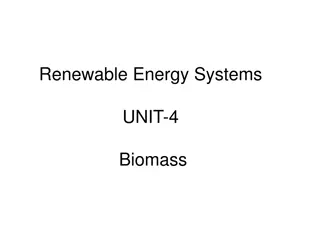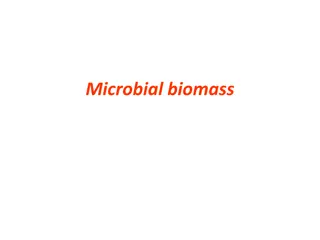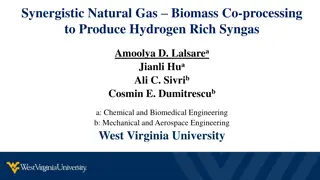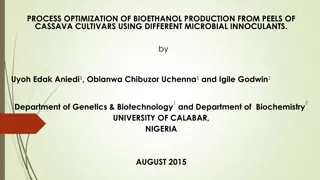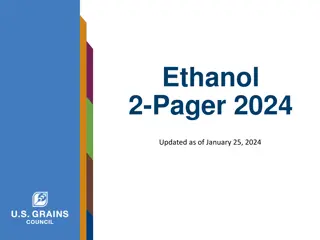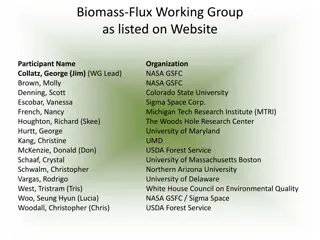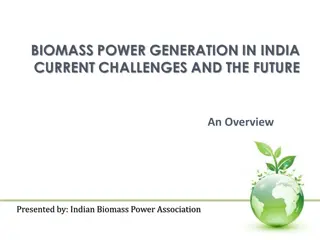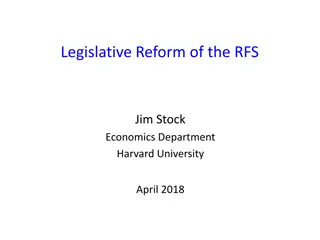Ethanol Production from Biomass: A Biochemical Perspective
Ethanol is a crucial ingredient in various products and beverages and can be produced from plant fermentation or the hydration of ethylene. This process involves utilizing wastes and plant products like molasses, sugar beets, and maize to convert carbohydrates into ethanol. The biochemistry of ethanol fermentation and its industrial production are explored in detail, highlighting the application of ethanol in different industries.
Download Presentation

Please find below an Image/Link to download the presentation.
The content on the website is provided AS IS for your information and personal use only. It may not be sold, licensed, or shared on other websites without obtaining consent from the author.If you encounter any issues during the download, it is possible that the publisher has removed the file from their server.
You are allowed to download the files provided on this website for personal or commercial use, subject to the condition that they are used lawfully. All files are the property of their respective owners.
The content on the website is provided AS IS for your information and personal use only. It may not be sold, licensed, or shared on other websites without obtaining consent from the author.
E N D
Presentation Transcript
Sengamala Sengamala Thayaar Thayaar Educational Trust Women s Educational Trust Women s College College (Affiliated to (Affiliated to Bharathidasan Bharathidasan University) (Accredited with A Grade {3.45/4.00} By NAAC) (Accredited with A Grade {3.45/4.00} By NAAC) (An ISO 9001: 2015 Certified Institution) (An ISO 9001: 2015 Certified Institution) Sundarakkottai Sundarakkottai, Mannargudi , Mannargudi- -614 016. Thiruvarur Thiruvarur (Dt.), Tamil Nadu, India (Dt.), Tamil Nadu, India. . University) 614 016. MEC III-BASIC BIOTECHNOLOGY-16SMBEBC3 Dr. R. ANURADHA ASSISTANT PROFESSOR & HEAD PG & RESEARCH DEPARTMENT OF BIOCHEMISTRY
ETHANOL PRODUCTION FROM BIOMASS ETHANOL PRODUCTION FROM BIOMASS
SYNOPSIS: INTRODUCTION INTRODUCTION BIOCHEMISTRY OF ETHANOL FERMENTATION BIOCHEMISTRY OF ETHANOL FERMENTATION INDUSTRIAL PRODUCTION OF ETHANOL INDUSTRIAL PRODUCTION OF ETHANOL * *FORMULATION OF MEDIUM FORMULATION OF MEDIUM * *DESIGNING OF FERMENTATION SYSTEM DESIGNING OF FERMENTATION SYSTEM * *CULTURE OF MICROBES IN FERMENTER CULTURE OF MICROBES IN FERMENTER * *RECOVERY OF ETHANOL RECOVERY OF ETHANOL APPLICATION OF ETHANOL APPLICATION OF ETHANOL
INTRODUCTION: Ethanol, also called alcohol alcohol, alcohol, is a clear, colourless liquid and the principle ingredient in alcoholic beverages like beer, wine or brandy. Because it can readily dissolve in water and other organic compounds, ethanol also is an ingredient in a range of products, from personal care and beauty products to paints and varnishes to fuel. Ethanol is a natural byproduct of plant fermentation and also can be produced through the hydration of ethylene. alcohol, ethyl alcohol ethyl alcohol and grain grain
Ethanolis prepared from the following wastes and plant products: Sugarcane molasses Cane juices Sugar beets Cassava Maize Corn Crop wastes
Carbohydrates are fond locked in wastes. The complex polysaccharides are converted into simple sugars. It is carried out by Closteridium Closteridium thermocellum, thermohydosulphuricum thermohydosulphuricum and C C. . thermosaccharolyticum The simple sugars are converted to ethanol by Zymomonas Zymomonas mobilis, mobilis, Thermoanerobacter Thermoanerobacter ethanolicus, etc., Some microbes are produce ethanol directly from carbohydrate wastes. Eg, Monilia, Monilia, fusarium thermocellum, C C. . thermosaccharolyticum. . ethanolicus, fusarium. .
BIOCHEMISTRY OF ETHANOL FERMENTATION:
INDUSTRIAL PRODUCTION OF ETHANOL: Formulation of medium Designing of fermentation system cultures of microbes in fermenters Recovery of ethanol
FORMULATION OF MEDIUM: The sugar concentration of cane molasses and of other carbohydrates in the waste is diluted to 10 18 %. This sugar concentration favors the growth of the micro organisms. Ammonium sulphate or ammonium phosphate is added to the diluted medium. The pH of the medium is adjusted to 4 - 5 to using dilute sulphuric acid.
The starchy media like corn, rye, and barley are hydrolyzed with dilute acids before they are pumped into the fermenter. The hydrolysis of starchy yields simple sugars which are directly converted to ethanol. Sometimes starchy feed stock is treated with amylase enzyme, extracted from Aspergillus Aspergillus and Rhizopus Amylase convert the starch into 80% maltose and 20% dextrin that can easily be converted into glucose. Rhizopus. .
DESIGNING FERMENTATION SYSTEM: The fermentation system consists of, Three molasses tank Three seed tanks A fermenter Wash camber Molasses storage tank
The stored molasses enter another tanks where the molasses are diluted properly with water. The diluted molasses then enter the sterilization tank for sterilization. The sterilized medium is used to carry out fermentation. The fermenter is connected with wash chamber by a pipeline. Harvested broth is transferred to the wash chamber for distillation.
CULTURE OF MICROBES IN FERMENTER: Sterilized medium in the sterilization tank is pumped into the fermenter then microbial inoculum is pumped into the fermenter to carry out ethanol fermentation. 330k temperature is found to be suitable for fermentation. Ethanol fermentation is complete in about 3 days.
The enzyme invertase converts sucrose in the molasses into glucose. This glucose is converted to ethanol by the enzyme zymase zymase. . invertase of Zymomonas Zymomonas (yeast)
RECOVERYOF ETHANOL: The fermented broth in the fermenter is known as wash. It is distilled in the washed chamber to recover ethanol. The distillation setup is called coffey still. It consists of 2 column, Analyser rectifier
Wash flowing through a folded pipe is heated in the rectifier. This pipe releases the contents at the top of the analyser. Steam is passed through the base of the analyser to carry the alcohol vapour to the base of the rectifier. The spent liquor is collected from the outlet of the analyser. Alcohol vapour in the rectifier is collected through a pipe jacketed with cool water to get 95% ethanol.
APPLICATION OF ETHANOL: Owing to its antibacterial and antifungal properties, ethanol (also known as ethyl alcohol) is used in many hand sanitizers and medical wipes. Ethanol is also used as an antiseptic and as a disinfectant. In cases of ethylene glycol poisoning or methyl alcohol poisoning, ethanol is often administered as an antidote. Several medications that are insoluble in water are often dissolved in ethanol. For example, ethanol (in concentrations ranging from 1% to 25%) is used as a solvent for some analgesics and mouthwashes.
Ethanol is the primary ingredient in many alcoholic drinks that are orally consumed for recreational purposes. It acts as a psychoactive drug by reducing anxiety and creating a feeling of euphoria in Humans. However, it also impairs cognitive and motor functions and acts as a central nervous system (CNS) depressant. Ethanol is used industrially in the production of ethyl esters, acetic acid, diethyl ether, and ethyl amines. This compound is widely used as a solvent due to its ability to dissolve both polar and nonpolar compounds. Since it has a melting point of -114.1oC, ethanol is used as an ingredient in cooling baths in several laboratories. It also serves as the active fluid in many spirit thermometers.





